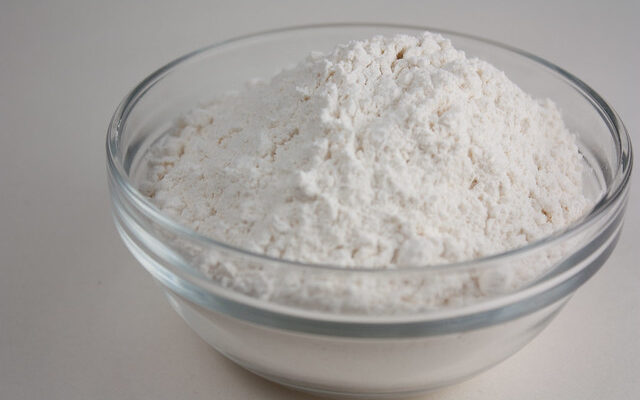In the UK, all purpose flour is commonly known as plain flour. It is a versatile type of flour that is milled from wheat grains and does not contain any raising agents like baking powder or baking soda. Plain flour has a moderate protein content, typically around 9-11%, which makes it suitable for a wide range of baking applications.
All purpose or plain flour is commonly used for making cakes, cookies, pastries, and other baked goods that require a tender texture. It can also be used for thickening sauces, batters, and gravies. However, it is worth noting that in some specific recipes, such as bread or other yeast-based products, a higher protein flour like bread flour may be recommended to achieve better structure and rise.
All-purpose flour is a versatile type of flour that is commonly used in a wide range of recipes. It is made from a blend of hard and soft wheat grains, which gives it a moderate protein content.
Here are some common uses for all-purpose flour:
- Baking: All purpose flour is frequently used in baking recipes for cakes, cookies, muffins, bread, and pastries. It provides structure and texture to baked goods due to its gluten content.
- Thickening agent: All-purpose flour is often used as a thickening agent in sauces, gravies, soups, and stews. When mixed with a liquid and heated, the flour’s starches swell and thicken the mixture.
- Coating and dredging: It is commonly used to coat meat, poultry, seafood, and vegetables before frying or baking. The flour helps create a crispy and golden exterior.
- Pancakes and waffles: All-purpose flour is a key ingredient in pancake and waffle batters. It provides the necessary structure and helps achieve a fluffy texture.
- Pasta and noodles: All-purpose flour can be used to make homemade pasta or noodles. It is mixed with eggs and sometimes water to create a dough that can be rolled out and cut into various shapes.
- Pizza dough: All-purpose flour is commonly used in pizza dough recipes. It helps create a chewy and stretchy texture when combined with yeast, water, and other ingredients.
- Breading and binders: All purpose flour is often used as part of a breading mixture for fried foods. It helps the breading adhere to the food and provides a crispy texture. It can also be used as a binder in meatloaf or meatball recipes.
Overall, all purpose flour is a staple in many kitchens due to its versatility and wide range of applications in both sweet and savory dishes.
How to Make All Purpose Flour?
To make all purpose flour, you will need a combination of hard and soft wheat grains. All purpose flour is typically a blend of different types of wheat to achieve a moderate protein content suitable for a wide range of baking applications. Here’s a general guide on how to make all-purpose flour at home:
Ingredients and Equipment:
- Hard wheat grains (e.g., red wheat berries)
- Soft wheat grains (e.g., white wheat berries)
- Grain mill or a high-powered blender
Instructions:
- Source your wheat grains: Look for both hard and soft wheat grains, which can often be found at health food stores, specialty grain suppliers, or online. Red wheat berries are commonly used for hard wheat, while white wheat berries are used for soft wheat.
- Cleaning the grains (optional): If your wheat grains appear dusty or contain impurities, you may want to clean them before milling. Sort through the grains and remove any stones, debris, or damaged grains.
- Milling the grains: Use a grain mill or a high-powered blender to grind the wheat grains into flour. Follow the manufacturer’s instructions for your specific mill or blender. It’s recommended to adjust the mill settings or blending time to achieve the desired fineness of the flour.
- Mixing the flours: Combine the freshly milled hard wheat flour and soft wheat flour in a large bowl. The ratio of hard wheat flour to soft wheat flour can vary depending on the desired characteristics of your all-purpose flour. A common ratio is 75% hard wheat flour to 25% soft wheat flour.
- Sifting (optional): For a finer texture and to remove any remaining larger particles, you can sift the combined flours using a fine-mesh sieve or a flour sifter.
- Storing the flour: Transfer the freshly made all-purpose flour to an airtight container or a sealable bag. Store it in a cool, dry place away from direct sunlight. Homemade flour may have a shorter shelf life than commercially produced flour, so it’s best to use it within a few months.
Note: Keep in mind that homemade all-purpose flour may not have the same consistency or exact protein content as commercially available varieties. It may require some experimentation to achieve the desired results in your baking recipes.
Remember to consider any dietary restrictions or allergies before using homemade flour. If you have specific dietary needs, it’s always a good idea to consult with a professional nutritionist or dietitian.
Is All Purpose Flour the Same as Plain Flour?
Yes, all purpose flour is essentially the same as plain flour. The terms “all purpose flour” and “plain flour” are used interchangeably in many countries, including the United States and the United Kingdom. Both refer to a versatile type of flour that is commonly used for a wide range of baking and cooking purposes. It is made from a blend of hard and soft wheat varieties, and it has a moderate protein content that makes it suitable for various recipes, including cakes, cookies, bread, and pastries. So, whether a recipe calls for all-purpose flour or plain flour, you can generally use them interchangeably.
All purpose flour is plain flour and does not contain any leavening agents like baking powder or baking soda. It is called “all-purpose” because it can be used for a variety of purposes in baking and cooking. If a recipe calls for self-rising flour, which already contains leavening agents, you cannot directly substitute it with all-purpose flour. However, you can make your own self-rising flour by adding baking powder and salt to all-purpose flour in the appropriate proportions.
What Can Be Used Instead of All Purpose Flour?
There are several alternatives to all purpose flour that can be used in various recipes, depending on dietary restrictions or personal preferences. Here are some common substitutes:
- Whole Wheat Flour: This is a healthier alternative to all-purpose flour as it contains more nutrients and fiber. It has a slightly denser texture, so it may not work well in recipes that require a lighter texture.
- Gluten-Free Flour Blends: For individuals with gluten sensitivities or celiac disease, gluten-free flour blends can be used. These blends typically consist of a mixture of flours like rice flour, tapioca flour, potato starch, and xanthan gum to provide structure.
- Almond Flour: Made from finely ground almonds, almond flour is a popular grain-free and low-carb alternative. It adds a nutty flavor and moist texture to baked goods. However, it does not have the same binding properties as wheat flour, so it is often combined with other flours or ingredients like eggs.
- Coconut Flour: Coconut flour is another gluten-free and grain-free option. It is highly absorbent, so you’ll need to adjust the liquid content in recipes when using it. It lends a subtle coconut flavor and can result in denser baked goods.
- Oat Flour: Ground oats create oat flour, which is a nutritious alternative. It works well in recipes like pancakes, cookies, and quick breads. If you need a gluten-free option, make sure to use certified gluten-free oats.
- Chickpea Flour: Also known as gram flour or besan, chickpea flour is commonly used in Indian and Middle Eastern cuisine. It has a slightly nutty flavor and works well as a thickener in sauces, as a batter for fritters, or in flatbreads.
- Rice Flour: Made from finely ground rice, rice flour is gluten-free and has a mild taste. It is often used in Asian cooking for batters, coatings, and as a thickener. Keep in mind that it has a different texture and can be slightly gritty.
When using alternative flours, it’s important to note that they have different properties and may yield different results in recipes compared to all-purpose flour. Experimentation and adjustments to the recipe may be necessary to achieve the desired outcome.
Why is it called all purpose flour?
All-purpose flour is called so because it is designed to be versatile and suitable for a wide range of baking and cooking purposes. The term “all-purpose” indicates that this type of flour can be used for various recipes, unlike specialized flours that are specifically formulated for particular uses.
All-purpose flour is typically made from a blend of hard and soft wheat varieties. The milling process removes the bran and germ from the wheat, resulting in a finely ground flour with a moderate protein content. This protein content is usually around 10-12%, which makes it suitable for a variety of recipes, including cakes, cookies, bread, pastries, and more.
Due to its moderate protein content, all purpose flour strikes a balance between the gluten-forming proteins (which provide structure and elasticity) and the starches (which contribute to tenderness). This balance allows the flour to work well in a wide range of recipes, providing sufficient structure when needed, while still yielding tender and light results.
How do I convert plain flour to all purpose flour
Plain flour and all purpose flour are actually the same thing in many parts of the world. The terms “plain flour” and “all-purpose flour” are often used interchangeably, especially in recipes. Both refer to a versatile type of flour that is suitable for a wide range of baking purposes.
However, in some countries, such as the United Kingdom, plain flour and all purpose flour may have slightly different meanings. In these cases, plain flour typically refers to a flour with a lower protein content, while all-purpose flour has a slightly higher protein content. The difference in protein content affects the texture and structure of baked goods.
If you come across a recipe that specifically calls for plain flour but you only have all-purpose flour, you can generally use them interchangeably without a significant impact on the final result. The protein content difference is usually minimal and won’t cause major issues in most recipes. Just measure the all purpose flour as you would the plain flour, following the same quantity indicated in the recipe.
It’s worth noting that if you’re working with a recipe that requires a high level of precision, such as delicate pastries or bread that requires specific gluten development, the slight difference in protein content may have a subtle effect on the texture and structure of the final product. In such cases, it’s best to follow the recipe as closely as possible or seek a specific conversion ratio if available.
Conclusion for All purpose flour
In conclusion, all purpose flour is a versatile and commonly used ingredient in cooking and baking. It is a blend of hard and soft wheat varieties, making it suitable for a wide range of recipes. All purpose flour provides structure and stability to baked goods, thanks to its moderate protein content. It is commonly used to make bread, cakes, cookies, pastries, and other culinary delights.
The main advantage of all purpose flour is its convenience and versatility. It eliminates the need for multiple types of flour in the kitchen, making it a staple in many households. With all-purpose flour, you can tackle various recipes without worrying about the specific characteristics of specialty flours.
However, it is essential to note that while all purpose flour can be used in many applications, it may not be the best choice for certain recipes that require specific flour properties. For example, bread-making enthusiasts may prefer bread flour with its higher protein content, which develops stronger gluten strands for better rise and structure. Likewise, delicate pastries or cakes may benefit from cake flour’s lower protein content, resulting in a tender and light texture.
In summary, all-purpose flour is a reliable and widely available ingredient that serves as a go-to option for many cooking and baking needs. Its versatility and convenience make it a valuable addition to any kitchen pantry, although specialized flours may be preferred in specific recipes that demand unique characteristics.
How can you tell if flour is all purpose?
To determine if flour is all-purpose flour, you can look for the following characteristics:
- Packaging: All purpose flour is commonly labeled as “All-Purpose Flour” on the packaging. Check the label or packaging for this specific designation.
- Color: All-purpose flour is typically off-white or cream-colored. It should not be extremely white like cake flour or have a darker tint like whole wheat flour.
- Texture: All purpose flour has a moderate protein content, which gives it a balanced texture suitable for a wide range of baking and cooking applications. It should feel relatively fine and smooth to the touch.
- Protein content: All purpose flour usually has a protein content ranging from 8% to 12%. This medium protein content allows for versatility in baking, as it provides enough gluten to give structure to baked goods but is not as high as bread flour.
- Purpose of use: Consider the intended purpose of the flour. All purpose flour is a general-purpose flour suitable for most baking needs, including cakes, cookies, bread, and pastries. If the flour is specifically labeled as self-rising flour, bread flour, cake flour, or whole wheat flour, it is not all-purpose flour.
If you are unsure about the type of flour you have, it’s always a good idea to check the packaging or consult the manufacturer’s website for more information.
What does all purpose flour look like
All purpose flour typically has a fine and powdery texture. It is a white or off-white color, although there can be slight variations in shade depending on the brand or type of wheat used. It appears as a smooth and uniform powder, with no visible lumps or clumps.
When you pour all purpose flour into your hand or a container, it will flow easily and softly, much like powdered sugar. It is lightweight and can easily be dispersed or sifted. However, when you squeeze it tightly in your hand, it will hold its shape temporarily before crumbling and falling apart.
Overall, all purpose flour has a soft and powdery appearance, making it versatile for a wide range of baking and cooking applications.
Also Read: What is a Boots Popsicle? A Delicious Frozen Treat Explained
Frequently Asked Questions (FAQ) About All Purpose Flour
Q: What is all purpose flour?
A: All purpose flour is a type of flour that is commonly used in a wide variety of recipes. It is made from a blend of hard and soft wheat, which gives it a moderate protein content suitable for a range of baking applications.
Q: Can all purpose flour be used for baking?
A: Yes, all purpose flour is a versatile flour that can be used for baking various items such as bread, cakes, cookies, pastries, and more.
Q: What is the protein content of all purpose flour?
A: The protein content in all-purpose flour typically ranges from 9% to 12%. This moderate protein level makes it suitable for a variety of baking purposes, including recipes that require both tenderness and structure.
Q: Can I substitute all purpose flour with other types of flour?
A: All purpose flour can be substituted with other flours, but the results may vary depending on the recipe. For example, you can use bread flour for a higher protein content or cake flour for a lower protein content. It’s important to consider the characteristics of the flour and adjust the recipe accordingly.
Q: Can I use all purpose flour for making bread?
A: Yes, all purpose flour can be used for making bread. However, bread flour, which has a higher protein content, is often preferred for bread recipes as it provides more structure and a better rise. If you use all-purpose flour for bread, the texture may be slightly different.
Q: Is all purpose flour suitable for gluten-free baking?
A: No, all purpose flour is not suitable for gluten-free baking. It contains gluten, which is a protein that gives baked goods their structure. If you need to bake gluten-free, you’ll need to use alternative flours like rice flour, almond flour, or a gluten-free flour blend.
Q: How should I store all purpose flour?
A: All purpose flour should be stored in a cool, dry place in an airtight container to prevent moisture absorption and keep it fresh. Avoid exposing it to direct sunlight or extreme temperature changes. When stored properly, all-purpose flour can last for several months.
Q: Can all purpose flour go bad?
A: Yes, like any other food product, all-purpose flour can go bad. Over time, it may become stale or develop a rancid smell if exposed to moisture or stored for too long. It’s best to check the expiration date and use it before that time for optimal quality.
Q: Does all purpose flour contain any additives?
A: All purpose flour may contain additives like ascorbic acid (vitamin C) or malted barley flour, which help improve the baking process or extend shelf life. Some brands may also enrich their all-purpose flour by adding nutrients like iron or B vitamins.
Q: Can I use self-rising flour instead of all-purpose flour?
A: Self-rising flour is a specific type of flour that already contains leavening agents, such as baking powder and salt. If a recipe calls for all purpose flour, you can substitute it with self-rising flour, but you’ll need to adjust the recipe by reducing or eliminating the amount of baking powder and salt that it calls for.




